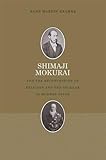Shimaji Mokurai and the Reconception of Religion and the Secular in Modern Japan / Hans Martin Krämer.
Material type: TextPublisher: Honolulu : University of Hawaii Press, [2015]Copyright date: ©2015Description: 1 online resource (246 p.)Content type:
TextPublisher: Honolulu : University of Hawaii Press, [2015]Copyright date: ©2015Description: 1 online resource (246 p.)Content type: - 9780824851538
- 9780824857219
- 200.95209034 23
- online - DeGruyter
- Issued also in print.
| Item type | Current library | Call number | URL | Status | Notes | Barcode | |
|---|---|---|---|---|---|---|---|
 eBook
eBook
|
Biblioteca "Angelicum" Pont. Univ. S.Tommaso d'Aquino Nuvola online | online - DeGruyter (Browse shelf(Opens below)) | Online access | Not for loan (Accesso limitato) | Accesso per gli utenti autorizzati / Access for authorized users | (dgr)9780824857219 |
Frontmatter -- Contents -- Acknowledgments -- Introduction -- Chapter 1: Categorizing Religion in Early Modern Japan -- Chapter 2: Early Meiji Buddhism and the Shintoist Challenge -- Chapter 3: From "Sectarian Teaching" to "Religion" -- Chapter 4: Western Sources of Knowledge -- Chapter 5: The Long History of Religion's Opposites: "The Secular" and "Secularization" -- Conclusion -- Appendix: Shimaji Mokurai, "Critique of the Three Standards of Instruction" (1872) -- Notes -- Character Glossary -- Bibliography -- Index
restricted access online access with authorization star
http://purl.org/coar/access_right/c_16ec
Religion is at the heart of such ongoing political debates in Japan as the constitutionality of official government visits to Yasukuni Shrine, yet the very categories that frame these debates, namely religion and the secular, entered the Japanese language less than 150 years ago. To think of religion as a Western imposition, as something alien to Japanese reality, however, would be simplistic. As this in-depth study shows for the first time, religion and the secular were critically reconceived in Japan by Japanese who had their own interests and traditions as well as those received in their encounters with the West. It argues convincingly that by the mid-nineteenth century developments outside of Europe and North America were already part of a global process of rethinking religion.The Buddhist priest Shimaji Mokurai (1838-1911) was the first Japanese to discuss the modern concept of religion in some depth in the early 1870s. In his person, indigenous tradition, politics, and Western influence came together to set the course the reconception of religion would take in Japan. The volume begins by tracing the history of the modern Japanese term for religion, shūkyō, and its components and exploring the significance of Shimaji's sectarian background as a True Pure Land Buddhist. Shimaji went on to shape the early Meiji government's religious policy and was essential in redefining the locus of Buddhism in modernity and indirectly that of Shinto, which led to its definition as nonreligious and in time to the creation of State Shinto. Finally, the work offers an extensive account of Shimaji's intellectual dealings with the West (he was one of the first Buddhists to travel to Europe) as well as clarifying the ramifications of these encounters for Shimaji's own thinking. Concluding chapters historicize Japanese appropriations of secularization from medieval times to the twentieth century and discuss the meaning of the reconception of religion in modern Japan. Highly original and informed, Shimaji Mokurai and the Reconception of Religion and the Secular in Modern Japan not only emphasizes the agency of Asian actors in colonial and semicolonial situations, but also hints at the function of the concept of religion in modern society: a secularist conception of religion was the only way to ensure the survival of religion as we know it today. In this respect, the Japanese reconception of religion and the secular closely parallels similar developments in the West.
Issued also in print.
Mode of access: Internet via World Wide Web.
In English.
Description based on online resource; title from PDF title page (publisher's Web site, viewed 02. Mrz 2022)


